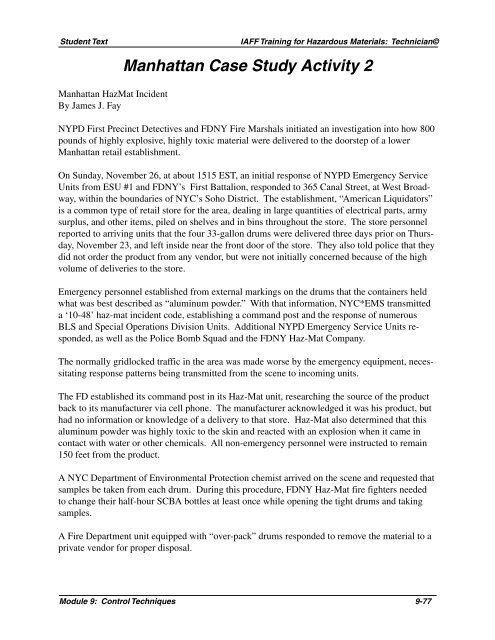Module 9: Control Techniques - International Association of Fire ...
Module 9: Control Techniques - International Association of Fire ...
Module 9: Control Techniques - International Association of Fire ...
Create successful ePaper yourself
Turn your PDF publications into a flip-book with our unique Google optimized e-Paper software.
Student Text IAFF Training for Hazardous Materials: Technician©<br />
Manhattan HazMat Incident<br />
By James J. Fay<br />
Manhattan Case Study Activity 2<br />
NYPD First Precinct Detectives and FDNY <strong>Fire</strong> Marshals initiated an investigation into how 800<br />
pounds <strong>of</strong> highly explosive, highly toxic material were delivered to the doorstep <strong>of</strong> a lower<br />
Manhattan retail establishment.<br />
On Sunday, November 26, at about 1515 EST, an initial response <strong>of</strong> NYPD Emergency Service<br />
Units from ESU #1 and FDNY’s First Battalion, responded to 365 Canal Street, at West Broadway,<br />
within the boundaries <strong>of</strong> NYC’s Soho District. The establishment, “American Liquidators”<br />
is a common type <strong>of</strong> retail store for the area, dealing in large quantities <strong>of</strong> electrical parts, army<br />
surplus, and other items, piled on shelves and in bins throughout the store. The store personnel<br />
reported to arriving units that the four 33-gallon drums were delivered three days prior on Thursday,<br />
November 23, and left inside near the front door <strong>of</strong> the store. They also told police that they<br />
did not order the product from any vendor, but were not initially concerned because <strong>of</strong> the high<br />
volume <strong>of</strong> deliveries to the store.<br />
Emergency personnel established from external markings on the drums that the containers held<br />
what was best described as “aluminum powder.” With that information, NYC*EMS transmitted<br />
a ‘10-48’ haz-mat incident code, establishing a command post and the response <strong>of</strong> numerous<br />
BLS and Special Operations Division Units. Additional NYPD Emergency Service Units responded,<br />
as well as the Police Bomb Squad and the FDNY Haz-Mat Company.<br />
The normally gridlocked traffic in the area was made worse by the emergency equipment, necessitating<br />
response patterns being transmitted from the scene to incoming units.<br />
The FD established its command post in its Haz-Mat unit, researching the source <strong>of</strong> the product<br />
back to its manufacturer via cell phone. The manufacturer acknowledged it was his product, but<br />
had no information or knowledge <strong>of</strong> a delivery to that store. Haz-Mat also determined that this<br />
aluminum powder was highly toxic to the skin and reacted with an explosion when it came in<br />
contact with water or other chemicals. All non-emergency personnel were instructed to remain<br />
150 feet from the product.<br />
A NYC Department <strong>of</strong> Environmental Protection chemist arrived on the scene and requested that<br />
samples be taken from each drum. During this procedure, FDNY Haz-Mat fire fighters needed<br />
to change their half-hour SCBA bottles at least once while opening the tight drums and taking<br />
samples.<br />
A <strong>Fire</strong> Department unit equipped with “over-pack” drums responded to remove the material to a<br />
private vendor for proper disposal.<br />
<strong>Module</strong> 9: <strong>Control</strong> <strong>Techniques</strong> 9-77
















